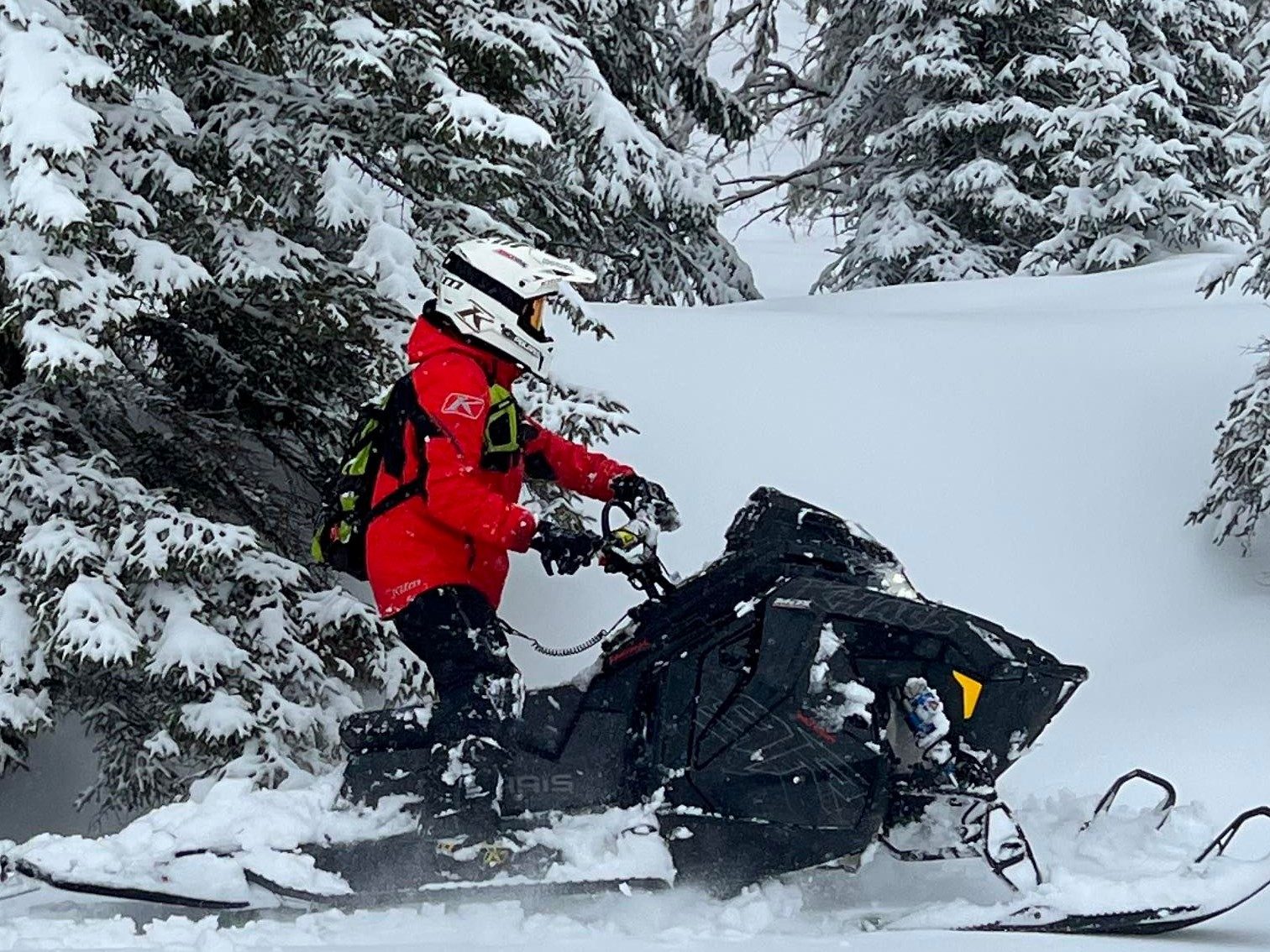Table of contents
Toggle- A Surprising Feeling of Rejuvenation
- First Ride: Unveiling the Polaris Khaos 146 po
- Taming the Sidehill with the Polaris Matryx RMK Khaos SLASH 9R 2023 146 po: An Alluring Challenge!
- Deep Snow and the Matryx Chassis
- Suspension
- Fuel Consumption and Engine
- Spark Plugs
- Primary Clutch P22
- Track
- 146-inch Tunnel
- Conclusion
- Polaris Matryx RMK Khaos SLASH 9R 2023 Strengths
- Polaris Matryx RMK Khaos SLASH 9R 2023 Weaknesses
- Read more of our Polaris test rides here:
Here is my assessment after covering over 1500 km off-trail with the Polaris Matryx RMK Khaos SLASH 9R 2023 146 po!
First and foremost, I would like to emphasize that I consider my skill level as intermediate/advanced. Furthermore, I had the opportunity to ride the Khaos 9R Slash (short tunnel) in Quebec, experiencing powder conditions at elevations ranging from 500 to 900 meters.
A Surprising Feeling of Rejuvenation
In broad strokes, this machine is regarded as a mountain snowmobile, offering features conducive to alpine riding styles. Regardless of your style or age group, the Khaos 9R will give you a rejuvenating sensation. Driving this agile and enjoyable machine makes you feel young and alive!
It’s essential to note that the Khaos is designed to provide a wilder off-trail snowmobiling experience. What sets it apart from its counterpart, the Pro RMK, is its ability to pivot on itself very responsively.
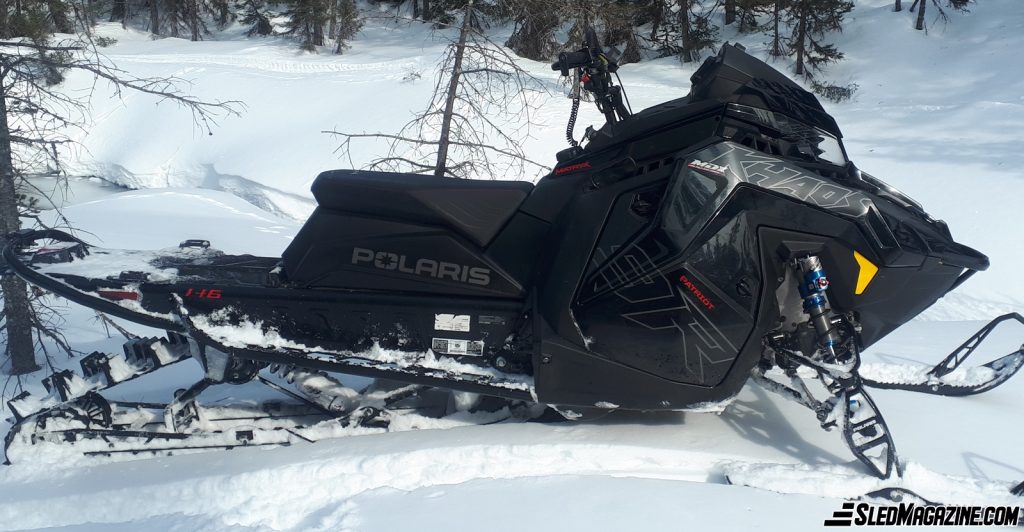
First Ride: Unveiling the Polaris Khaos 146 po
From the very first turn, it becomes evident that the Polaris Khaos 146 po is an exceptionally maneuverable machine, easy to tilt. Transitioning from a 155-inch Pro RMK to this Khaos version is unquestionably the pinnacle of freestyle mountain snowmobiling in this segment.
Instant Power and Riding Pleasure (ss4)
The 9R engine is undoubtedly the naturally aspirated powerhouse, delivering the industry’s most instantaneous response. The 146-inch, 2.6-inch Series 6 tracks may seem short, but its efficiency shines in the typical driving conditions of Quebec, making this tunnel/track length a wise choice.
Of course, an adaptation period is necessary to master the new weight transfer and pivot points. However, the Khaos excels at carving through the steepest slopes, providing a delightful and addictive riding experience. Moreover, this machine is so enjoyable to flip around that I am now hooked on this new style.
Freedom and Lightness
The Khaos 146 po categorically refuses to climb steep slopes! No worries—just a simple flip at 90, 180, or 270 degrees, and we’re off on a new ascent line. Its ease of repositioning is a distinctive asset compared to other models. The moment you touch the handlebars, a sense of freedom and lightness takes over! Of course, be prepared to give the machine a bit of a shake to derive maximum pleasure.
Let’s remember we’re talking about the RMK Khaos 146 po without an electric starter (approximately -18 lb), not the Pro RMK 155 known to be less prone to lifting the front. The weight difference is noticeable, contributing to the overall experience and exceptional maneuverability of the Khaos.
The rear shock attachment points are somewhat different from the Pro RMK. This is the significant difference between the two models. Hence, I believe a more athletic approach is needed for riding on very steep slopes! The machine tends to jolt you and requires more energy to drive than the Pro RMK.
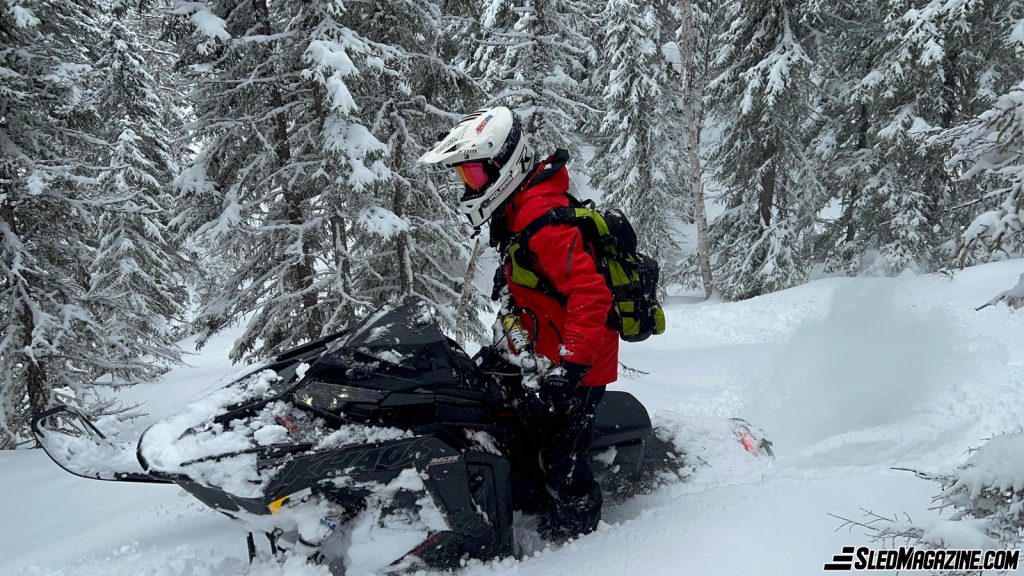
Taming the Sidehill with the Polaris Matryx RMK Khaos SLASH 9R 2023 146 po: An Alluring Challenge!
The recurring question posed to me was about the capability of a 146-inch model to maintain its line on a sidehill. Due to a shorter track and less snow coverage, the rear of the machine tends to descend and bog down more compared to a 155-inch model and above! This characteristic impacts the trajectory stability when the Khaos rider attempts to navigate a low-speed course.
Hence, it is sometimes necessary to dare and maintain a higher speed when traversing a steep mountain laterally. However, when it’s time to execute a 180° turn for a staged ascent, it becomes noticeably easier. This is due to the mass being closer to the rider, resulting inevitably in better maneuverability in these delicate situations.
Deep Snow and the Matryx Chassis
The Matryx chassis undoubtedly positions itself as one of the best in the industry to date. Its reputation, built on its exceptional ability to extricate itself from the snow, is truly astonishing when one witnesses its effectiveness on this platform!
On several occasions where I found myself stuck, thinking it would be impossible to get out on my own, a slight clearance of snow from the front of the Khaos 9R, a quick throttle, and presto… The Matryx almost pulled itself out by climbing back onto the snow. This is an eloquent demonstration of the power and ingenious design of the Matryx chassis, a true revolution in the riding experience.
Suspension
The Khaos comes equipped with Walker Evans front and rear suspensions with external reservoirs. While some purists disdain these shocks for replacements, I was satisfied with their performance. Some of these criticisms seem related to company oil and internal seal issues that may be more prone to causing leaks.
I recommend starting the day by gently riding the first 5 km, allowing the suspensions to warm up gradually. That being said, the original suspensions of the RMK Khaos Slash are significantly more performance-oriented than the original single-spring suspensions of the Pro RMK. I would like to add that the optional replacement surpluses that Polaris offers for the Pro RMK are worth it. You’ll appreciate them even more when returning on often battered federated trails at the end of the day!
Fuel Consumption and Engine
Once the engine broke in, the fuel and oil consumption of the Patriot 9R pleasantly surprised me. Anticipating a greater thirst than the Patriot 850, I found that the 9R, compared to the Patriot 850 equipped with a Clutch performance kit, was equivalent or even more reasonable.
The beauty of this engine lies in its ability to unleash enough power without requiring modifications to improve engagement responsiveness. However, the 9R engine is known to reach higher RPMs, 250 more than the usual standard. Although the engine reacts sharply, it stagnates as soon as you reach 75–90 km/h, depending on the configuration.
The electric starter option costs about $550. Repeated manual starts, combined with the high compression ratio of the Patriot 9R, can become exhausting. This is particularly felt during the initial start in cold temperatures! It’s an aspect to consider for those who prefer the convenience of an electric start.
Spark Plugs
Similar to most Polaris 2-stroke engines, it is suggested to warm up the engine for at least 5 minutes or reach a temperature of 20 to 25 ° before departure. Even when warm, it is preferable not to start for periods of 2 minutes or less. The fuel injector programming’s generosity during startup can lead to flooding the engine. In such a situation, replacing the spark plugs is necessary, followed by a restart with the throttle fully engaged. This issue occurred twice over the 1500 km traveled.
Primary Clutch P22
The primary P22 transmission, introduced last year (2022) in the Patriot 850 Boost engine, is now housed in the Patriot 9R engine. This transmission no longer features belt height adjustment screws but adjusts through a ball bearing located within the P22. It’s essential to note that this transmission couples with an impressive 110 lb/ft and requires the use of a less common Torx T60 socket in mechanical assembly.
While incidents, like broken retaining screws and internal Spyder stars bursting, have been reported by western snowmobilers, we believe the introduction of this P22 may not necessarily pose problems for the eastern region. Our terrain’s ascent lines do not demand full-throttle use for extended periods. Additionally, modifying an 850 cc engine to 900 cc generates more heat and stress when overworked. This matter remains to be tracked, especially concerning the redesign of the P22 for 2024 and the recall of 2023’s P22.
However, it’s crucial to mention that the Quick Drive ensures instantaneous and lively responses. This eliminates the need for a “transfer case” for Polaris Mountain segments.
Track

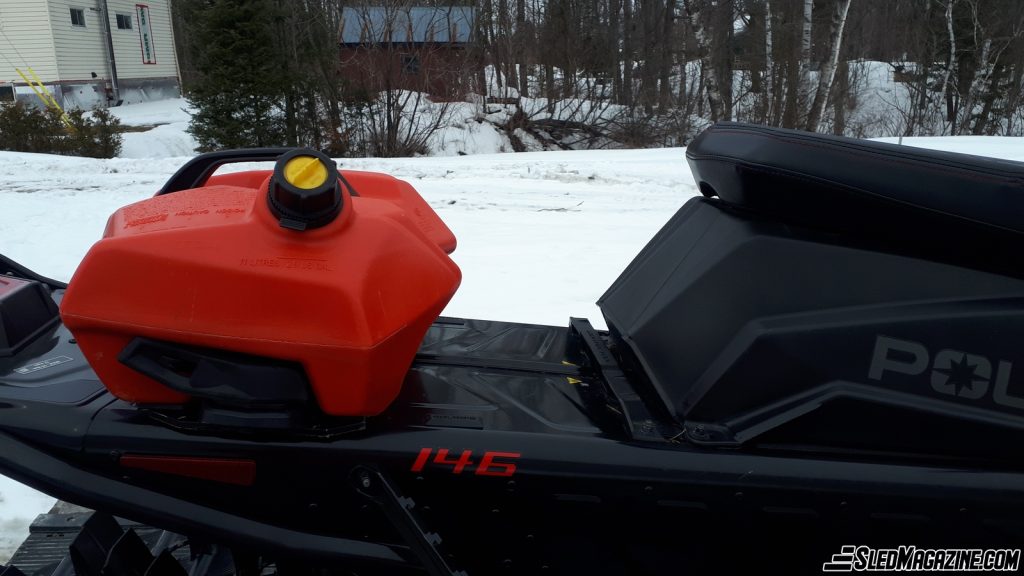
The lightweight 2.6-inch Series 6 track with exclusive Polaris technology positions itself on the performance side with flair. Combining a sufficiently flexible and rigid heel, it efficiently performs its task. However, one aspect warrants consideration: the grip of the simple center idler on the track. In snowmobiler jargon, it is prone to “ratcheting” due to the limited contact surface between these two elements. In some situations, it may tend to slide, emphasizing the importance of keeping the track adequately tensioned.
The substantial power of the 9R’s 175–180 horses doesn’t make preventing this escape phenomenon any easier! Despite this, after over 1500 km exclusively in off-piste conditions, all lugs have withstood the rigor of my trials.
Polaris offered two track height options for the Khaos 146, namely 2 inches or 2.6 inches of lugs. This choice allows snowmobilers to adapt the machine to their preferences and the type of terrain encountered, offering appreciable flexibility to optimize performance in varied conditions.
146-inch Tunnel
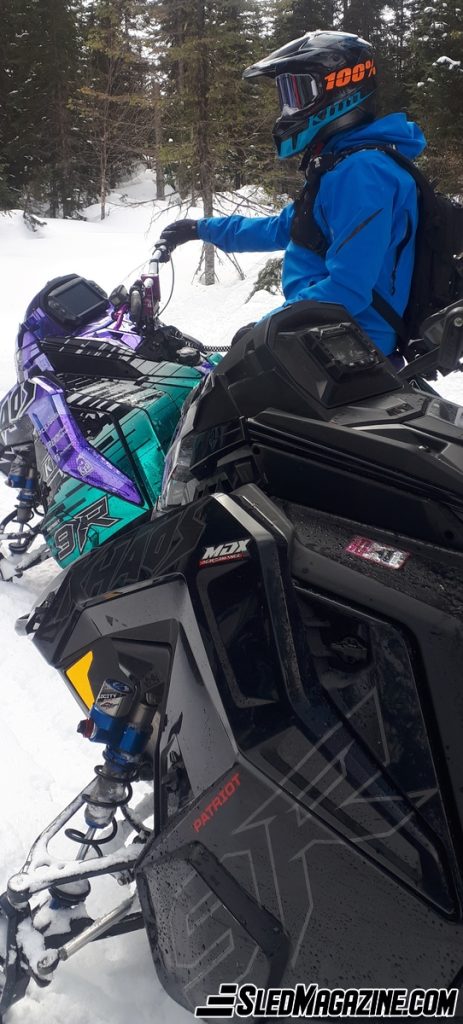
Certainly, a 146-inch Slash tunnel offers few options for vacant space. Accessories such as additional fuel reserves, tunnel bags, and shovel holders are limited at this level. In such circumstances, one must use tricks to bring the essentials for a full day of snowmobiling.
Hence, the backpack emerges as the most practical option.
Conclusion
In conclusion, I want to specify that, in the encountered conditions, there was never a moment where I would have been advantaged by a longer track due to my riding style. The terrains I cherish, consisting of ruts and serpentine ascents with elevations reaching up to 900 meters, are perfectly suited for the RMK Khaos SLASH 9R 146 configuration. The 9R engine has met my expectations, providing a remarkable power transfer from the engine to the track.
Undoubtedly, the RMK Khaos SLASH 9R 146 will satisfy the majority of snowmobilers in our region. The premium Walker Evans suspensions, with their flexibility, are a gold standard in the configuration of this snowmobile. Moreover, with the arrival of this engine in the Matryx platform with a short tunnel, I am convinced that a new era is unfolding in the realm of off-piste riding.
Suited for the Quebec Backcountry?

Throughout my trials, I consider it a model perfectly suited for the Quebec backcountry. I can confidently state that it’s the model that has provided me with the most sensations, all models considered!
As for what lies ahead, the perspectives are yet to be discovered.
Acknowledgments
My thanks go to Polaris Snowmobiles, RPM Rive-Sud, and Motoneiges.ca, who allowed me to explore the features of the 2023 RMK Khaos SLASH 9R 146.
Polaris Matryx RMK Khaos SLASH 9R 2023 Strengths
- Power
- Ability to Float on Snow
- Precision of Original Gripper Skis
- 6-Liter Fuel Tank
- Maneuverability
- Lightweight
- 6-Inch Track
- Responsiveness of the P22 and Quickdrive
Polaris Matryx RMK Khaos SLASH 9R 2023 Weaknesses
- We would appreciate the introduction of a capacitor starter, lighter by approximately 15 lb than the traditional electric starter!
- We would also like to see a motocross-style handlebar with a 45-degree hook.
- Sturdier lower front tables.
- Reversible snow scraper with carbide tip (coming for 2024 reversible scrapers).
- Skinz hood vent filter (photo).
- Improved reliability of the P22 clutch (screws and spyder), at least for riders in the west.
- Two idler gears instead of one for certain models (for the 146-inch versions).

